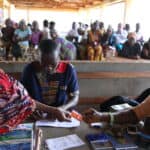The Implications of Global Health Equity: Why Pursuing Equity May Actually Harm the Poor
The concept of global health equity has gained traction in universities, governments, global health organizations and even some businesses. The number of yearly publications on health equity was negligible until the 1990s, and ballooned to more than 7,000 by 2017. Today, many universities include some form of a global health equity program, and there is even a University of Global Health Equity in Rwanda — as well as a Center for Global Health Equity here at the University of Michigan.
But before ubiquity turns to unquestioned acceptance, it’s worth thinking about the concept a bit more carefully. Are there compelling reasons to think that global health equity, at least as it is typically defined, will necessarily benefit those with the poorest health in the world? Might pursuing the goal of health equity between global populations actually harm the poor? That begs the question: What is meant by global health equity?
Defining Global Health Equity
The definition of health equity matters because it translates into actions taken by governments and multinational organizations. The goal implied by the term thus has real consequences for individuals impacted by efforts to reach it. So it’s important to ask: What exactly do we mean by equity, how should it be measured — and what should be done to achieve it?
Margaret Whitehead, writing in the early 1990s before she became the founding head of the World Health Organization’s (WHO) Collaborating Centre for Policy Research on Determinants of Health Equity, said “the term ‘inequity’ as used in WHO documents refers to differences in health that are not only unnecessary and avoidable, but in addition, are considered unfair and unjust.” Subsequent definitions of “differences in health” vary, but most focus on health outcomes.
Thus, the first challenge in pursuing global health equity is determining what outcomes to pursue and how to pursue them. Whitehead recognizes this difficulty in pointing out that her definition depends on an understanding of what is necessary and what is avoidable, and on judgements of fairness and justice. But acknowledging the problem doesn’t make the solution any more obvious. The diversity of patients from various global locations — in terms of maladies, environment, ancestry, income and preferences — renders any single health-outcome-based definition virtually impossible.
Consider an example: In proposing their own definition of global health equity, August et al. focus on the disparity in COVID vaccinations, pointing out that the percentage of the population that had received a vaccine in early 2021 was less than 1% in low-income countries, while high-income countries had “more than double the doses needed to cover their citizens.” Though actual vaccination rates were not 100% anywhere, regardless of the availability of the vaccine, there was and continues to be a significant difference in the percentage of the population that is vaccinated when comparing low- and high-income countries. The percentage of the population in mid-2021 that had received one dose of the vaccine in the U.S. was 61%, compared to about 9% of the African population by the end of 2021. Even by late 2022, only a quarter of the population in Africa was estimated to be fully vaccinated. Based on these numbers alone, this would seem to be a clear example of a troubling lack of equity that warrants urgent attention in the global health sector.
However, we find a very different discrepancy if we instead focus on death rates due to COVID. High-income countries have an average of 208 deaths per 100,000 due to COVID, compared to seven deaths per 100,000 in low-income countries. If reaching health equity is the goal, does that mean the global health sector should focus more of its efforts on reducing COVID mortality in high-income countries? Or should it focus on doing more to increase vaccination rates in low-income countries?
For the sake of argument, suppose that vaccination rates are to be the focus. There is still the question of determining what action to take. The reason for the discrepancy is not that vaccines are being withheld from low-income countries or priced too high for their citizens. Rather, it’s due to supply chain impediments, limited or inadequate storage facilities, and a population that has chosen not to take the vaccine even when offered. Spending more money on production of the vaccine will not address these issues. If the answer is to improve the supply chains, what specifically needs to be done? Should software systems be developed or revamped? Should refrigeration be increased? Should more resources be spent on efforts to encourage vaccine uptake among populations that are reluctant to receive them?
Taking this question a step further, what if we think about healthcare more broadly? COVID accounted for an estimated 256,000 deaths in Africa between 2019 and July 2022. Even if all of those deaths had occurred within one 12-month period, that would have put COVID at 10th on the list of killers in Africa, based on 2019 numbers. With that in mind, would resources spent on achieving COVID vaccine equity in Africa be better spent on treatment and awareness campaigns for tuberculosis, HIV/AIDS, diarrhea, malaria — or other more persistent and bigger killers on the continent?
Some might argue that we should use a broad measure of health of a population to measure equity. But even that requires a decision on what measures to focus on — e.g., disability-adjusted life years, life expectancy, etc. — and more troubling, it is an ex-post measure that is not terribly valuable in guiding ex ante decisions.
Who Decides What Health Equity Means?
The COVID example also illustrates a second challenge: Who determines the answers to the questions posed above? Any definition of global health equity requires someone to make decisions — from what aspect of health to target, to the best way to address targeted health problems, to how to compare the seriousness of different maladies and navigate the trade-offs inherent to prioritizing one over another. Who makes these decisions?
The answer is: not the poor. Well-meaning leaders of various stripes will make decisions on behalf of the poor, acting in what they believe to be the best interests of these communities. In so doing, these leaders will take decision-making power away from the poor. Questions about agency, and how to ensure that individuals have control over key decisions in their lives, pervade discussions about alleviating poverty. But it is hard to reconcile those discussions with the inherently top-down notion of global health equity. (Note that this problem is not unique to global health equity — it is true for any decisions made by a central authority.)
It is hard to overstate the negative consequences of this. Convincing individuals that they have little control over their own lot in life — or what their possibilities even are — takes away their most fundamental rights: their freedom to determine who they are and what they become.
Health Equity and Improving the Health of the Poor are Not the Same
Even if we successfully address the challenges of defining health equity and determining how to pursue it without disenfranchising the poor, it seems unlikely that proponents really want to pursue the goal of global health equity. Taken literally, a solution that resulted in no healthcare for anyone in the world would satisfy the goal of global health equity. And any measure that decreased the care available to those with the best healthcare would be an improvement in equity — even if the care available to disadvantaged populations remained unchanged.
Perhaps that seems a bit extreme, but how would we answer a more realistic question: If our best way to improve the healthcare of the poorest populations also results in an even greater improvement in the care provided to the wealthiest populations, would we oppose it on the grounds of equity?
Improving the health of those with the worst healthcare — typically the poorest populations — is not the same as increasing equity. In fact, improving the health of the poorest populations may depend on even greater improvements in the health of the wealthiest, thereby resulting in an even greater disparity in terms of equity. Consider a few examples.
In 2006, Brook Fekadu worked to become qualified by General Electric to service and repair GE imaging equipment. He started a company called Pioneer Diagnostics Center, and purchased the first MRI in Ethiopia, then provided MRI services to those able to pay for them. In doing so, he provided a service that was previously unavailable in the country. His company trains people to install, maintain and repair equipment for his clients. The lack of these services is the greatest constraint in the provision of imaging services in Ethiopia.
However, his MRI services aren’t available to all patients in the country. In fact, they are only available to those who can afford them — a group that was already receiving healthcare that was better than that available to the poor. Thus, the gap between the healthcare provided to the wealthiest populations and the poorest populations in Ethiopia grew.
Is that bad? Think about the longer-term implications. Fekadu’s business increased both the demand for technicians able to offer imaging services, and the incentive for other individuals to enter these professions. It also increased the price paid for such services, and thus the incentive for other imaging companies to enter the market. Over time, this has led to more imaging equipment, more facilities that offer MRIs and more Ethiopian citizens with access to those services. If the real goal is improvement in the healthcare available to the country’s poorer populations, the initial decrease in health equity caused by Fekadu’s foray into the market has been beneficial.
Perhaps thinking about health equity in the context of two Ethiopian populations is too limited, so consider global populations — some with access to the best healthcare in the world. The development of medications typically focuses on the diseases of the wealthiest populations, and the COVID vaccine is a remarkable example. Within a stunningly short period of time, companies developed, tested and provided vaccinations, focusing first on these wealthier markets. Would this have happened if the only consumers for the vaccine were unable to pay for it? Certainly not: The incentive for these companies to devote the resources necessary to develop, test and distribute a new vaccine was provided by large populations able and willing to pay (often through their deep-pocketed governments) for such a vaccination. Once developed, it could be (and has been) made available more broadly, even if this hasn’t happened at the pace desired by some advocates for global health equity. Thus, while some scholars highlight the development and rollout of the COVID vaccine as an example of failure in terms of health equity, it was a smashing success if our goal was to make the vaccine available to the poor quickly. The CDC states that the research and discovery phase of vaccine development alone often takes 10-15 years, yet the first COVID vaccines were being shipped to Africa in March 2021, just one year after the World Health Organization declared the virus to be a pandemic.
These examples illustrate how improvements in the healthcare available to the poorest populations often begin with improvements in the healthcare available to the wealthiest populations. The fact that these products and services are provided in the hope of making profits does not diminish their value — indeed, the profit motive provides the incentive for companies and equity capital to invest in and develop these life-saving innovations in the first place. Asking these private sector players to forgo a return on this investment is analogous to asking those who provide labor to forgo wages.
The profit motive also helps ensure the sustainability and widespread distribution of new healthcare innovations. If a health product or service covers all its costs, including capital costs, by generating profits, this increases the likelihood that it will be provided more broadly than products or services provided through donations or governments. There are two reasons for this: First, companies that generate profits (and thus must have covered all other costs as well) have the incentive and the ability to reinvest in their own operations to increase their output, thereby reaching more customers. Second, profitability attracts competition, and these new entrants will further increase the amount of the product or service available to the population, while also increasing their competitors’ incentive to further innovate, resulting in even better or lower-cost options. In contrast, if revenues do not cover costs, providers must rely on convincing others (mostly donors and governments) to cover these expenses — a costly and outcome-constraining endeavor.
Why the Meaning of Global Health Equity Matters
Some might argue that the term global health equity aims to communicate a broad moral objective that doesn’t necessarily imply specific actions. But if the push for global health equity isn’t intended to drive any actions, it is devoid of value. If it is intended to guide activity, we should care about how it is defined and understood — and thus what actions it drives.
Imagine that a mission-driven healthcare provider motivated by a belief in global health equity offers its services for free in certain periods of the year (something that actually happens). Consumers will initially be grateful, and the goal of equity may be temporarily advanced — but other local providers will lose revenue to this provider, thereby undermining their ability to provide financially sustainable care. In the long run, consumers will not be as grateful and local health equity may actually be undermined, since the mission-driven provider will vanish once its funding runs out, and the low-cost providers it undercut may have gone out of business. Where local providers exist, healthcare donors are actually harming local patients and economies.
By the same token, global health equity sounds like an admirable goal, but actions taken or discouraged to advance this goal can be damaging to the poorest populations. We should be very careful when considering any decisions made in the name of global health equity, to ensure that the focus on equity doesn’t result in harm to the poorest populations.
Paul Clyde is Clinical Professor of Business Economics and Public Policy and Movses and Maija Kaldjian Collegiate Lecturer of Business Economics and Public Policy at the University of Michigan. He is the former president of the William Davidson Institute (WDI), NextBillion’s parent organization.
Photo courtesy of Pixabay.
- Categories
- Health Care




